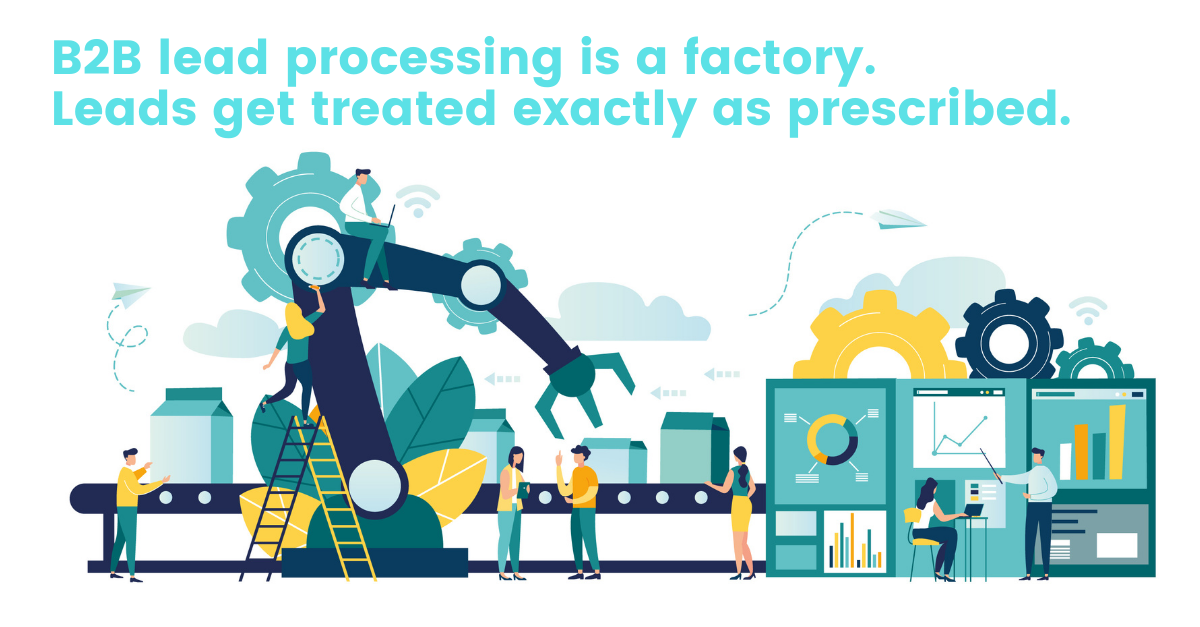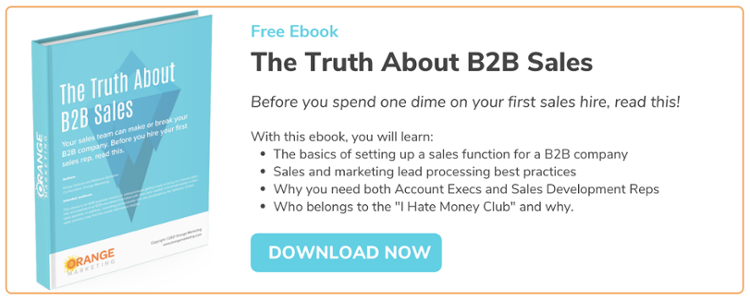Table of Contents
- Introduction
- Why Do You Need a Scalable, Repeatable, Predictable Sales Pipeline Management Process?
- What is the Best Practice for Deal Stages?
- What is the Minimum Needed on a Deal?
- What Sales Roles are Critical to Start a Company
- How Do You Prioritize Which B2B Leads to Contact?
- What Are Lead Processing Best Practices?
- What is the “I hate money” Club?
- Summary
Introduction
We all can picture the bright, good-looking, smooth-talking sales executive driving a Tesla and taking Friday afternoons to improve her golf swing, and we think with envious eyes, "Wow, she has THE life."
We know every last one of our B2B senior executives wants 100% of their sales team driving high five-figure cars. Expensive sales rep rides are a sign revenue is pouring in, and the company is wildly successful.
But what does it take for a sales rep to be highly successful? What is going on behind the scenes with marketing leads?
For us, a high-performing sales team is like a glacier. We can see the shiny parts sticking out of the water. Still, as the Titanic can attest, there is much more to a glacier than meets the eye, including the symbiotic relationship between sales and marketing. Marketing expenditures can quickly become pointless without a good sales team to pick up the leads and turn them into revenue.
In this eBook, we will go into detail about what's below the surface of a high performing B2B sales team:
- We will provide you the basics of setting up a sales function for a B2B company with the consideration purchase.
- We will discuss sales and marketing lead processing best practices,
- Finally, we end with six tales from the "I Hate Money Club", otherwise known as sales teams who engage in revenue-reducing behaviors.
Let's get started, shall we? And, we'll begin by covering the boring bits.
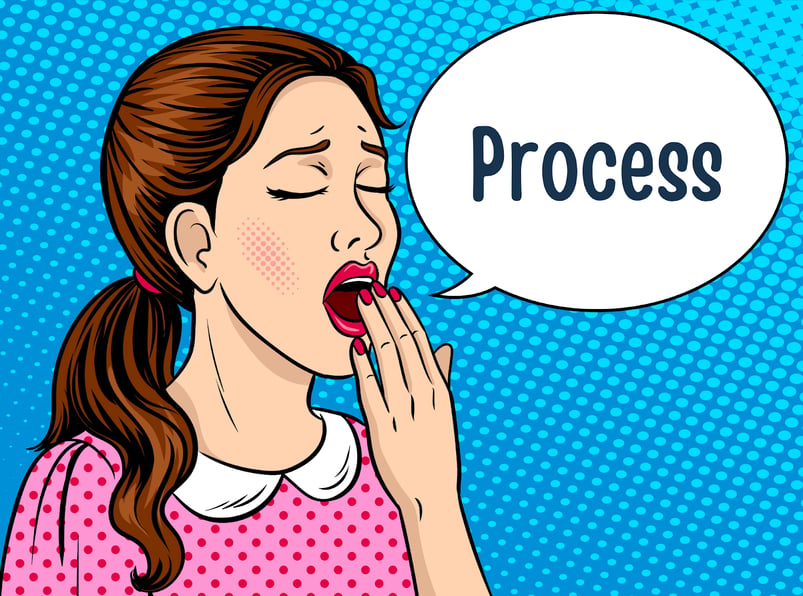
Why Do You Need a Scalable, Repeatable, Predictable Sales Pipeline Management Process?
What investors in a b2b startup want to see is a scalable, repeatable, and predictable sales process. They want this because it helps them understand when, or if, they’ll get their money back. And what many startups do is the antithesis of that. They'll hire a sales rep they think is successful and intelligent, who will pound the phones and get some deals.
Counter-intuitively, pounding phones and sending emails, using personal contact and LinkedIn lists, is really what the founders should be doing to get the company’s very first customers. As founders learn, once you have product-market fit, randomly contacting anyone you can think of is not repeatable and scalable.

It's that inflection point when you're getting ready to bring on a sales team where you need sales to consistently follow an order of operations and sell your product in the same way. Their pitch should correspond closely to what your marketing says and how the product works, which helps with product stickiness and retention.
To accomplish scalability and repeatability, you have to train sales reps the same way.
Orange Break
We have a client who is getting ready to go BIG. We created marketing acquisition communications and lead nurture processes consistent with their sales rep discovery questions, sales presentation, and the product and what it does from advertising to the website. That's the holy grail.
Here’s the wake-up call — obtaining consistency between teams – product development, marketing, sales, and service — has taken this “startup” four years with countless iterations. Four years is not unusual.
The marketing communication attracting your leads must match the core message for your Ideal Customer Profile (ICP) and your perfect Persona. There may be multiple of each of these. You will more consistently get leads that are a good fit when the marketing communication matches what your product does and what the sales reps say.
Processing leads in a consistent and repeatable way is critical for good fit leads, especially at scale. And your sales team has to trust the process and your thoughtfulness in execution. Trusting marketing and the process is in stark contrast to sales reps picking and choosing through a lead pile, treating each lead according to whatever the sales reps think is best.

What is Lead Processing?
In short, lead processing determines if leads are a good fit, unqualified, or maybe ready for sales on another day (marketing nurture). You want to get these answers as quickly as possible. If leads are qualified, process should be structured to determine whether or not leads move to the next deal stage by something that the customer has agreed to within your sales process.
Prospect agreement to move forward in the process is a real “aha” moment for many founders. Your investors want you to have a reliable forecast. Unreliability means:
- If you promise 30% growth in MRR and then do 3%.
- Or conversely, if you say you will do 30% MRR and you do 80%.
The founders and the startups that consistently get showered with money are the ones who prove that they can meet the forecast they've provided their investors. And having a consistent lead process with a constant deal processing pipeline process begets forecast predictability.
What is the Best Practice for Deal Stages?
You want a forecast that is as accurate as possible. And the best way to do that is to have a structured sales process where you know if a person gets to a particular stage in the sales process, they are X percent likely to become a customer. Most CRMs facilitate just such a calculation. (Full disclosure, we sell HubSpot Sales CRM because it allows us to implement standardized sales and marketing processes quickly.)
What is the definition of a sound deal stage?
There is an art to defining deal stages. People always want to know "how many deal stages?" We like to advise clients to have as many as necessary, but as few as possible. The deal should align with the buying process, not the selling process.
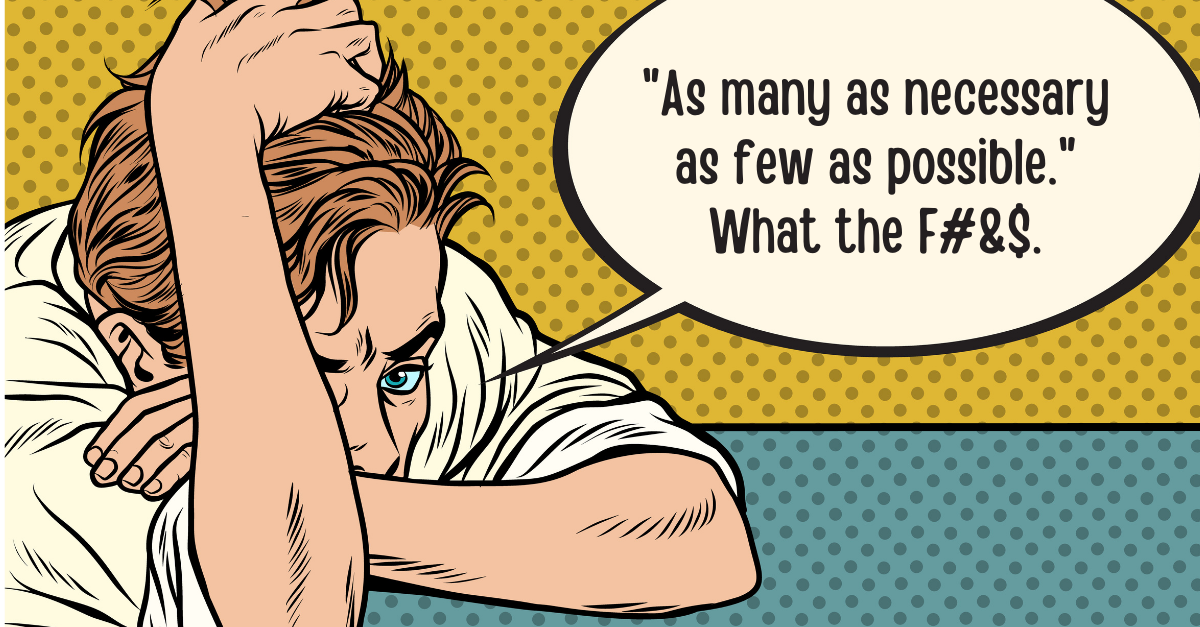
A sound deal stage is objective, such as something that your prospect has agreed to do. And sometimes, it may correlate to an internal step in your selling process. Most deal boards are Kanban-style, and sales managers may use them for both forecasting and process management.
A typical first step on a deal board is something like "Discovery Call Scheduled," which means the prospect has AGREED to a meeting. And that means that this idea of a deal is a reality.
Prospect agreement is the big differentiator because a sales rep left to their own devices may think, "Yeah, that guy replied to my email and said 'sounds interesting,' and now I marked them as a deal."
A person who said, "sounds interesting," is no more likely to become a customer than a person who wrote back, "Dogs are cute 🐾." (Well, they are). The prospect hasn't taken concrete action to move forward.
Orange Break
We walked into a client recently with 16 deal stages. Wow. That is a lot. What are the odds the sales rep and the sales manager have the same understanding of the definitions of all these stages? Zero. And after private team interviews, we discovered it was precisely that … zero. And what was their forecast reliability? Not great.
After you define your stages, the next step is assigning a percentage chance to become customers. "Statistically speaking, out of every time we have a discovery call, 10% of them become customers." What you are doing is beginning to delineate both your deal stages and the statistical probability of closing.
Fundamental sales forecast 101 stuff, right? 😎
($ Amount) times (% Close/Won Probability) = Forecast Revenue.
Strictly via repetition, you begin to learn that, 10% of the time, those people in deal stage one become customers. Therefore, when that person accepts a meeting, you know it’s possible to forecast revenue.
You don't want to add granularity to your deal stages if stages don’t advance the statistical likelihood of the close. So, you need to add steps that are meaningful and drive the chances of closing the deal. For example, our previous example was ”Discovery call scheduled.” You could have your first stage as “Discovery call complete” because a complete discovery call is the one that moved the needle. However, most sales managers will want to know “Discovery call scheduled,” and the deal board starts there for them.
After “Discovery complete,” you know most of the sales criteria for a legit deal (budget, authority, need, timeframe). Your next step may be a “Demo scheduled.” Then your next step may be “Demo complete.” Or, if the prospect is not a good fit, then its next step is “Closed lost,” and that’s okay. When you move the opportunity to the next stage, the guideline is that the prospect agrees to do something.
Sample deal stages with closed won percents
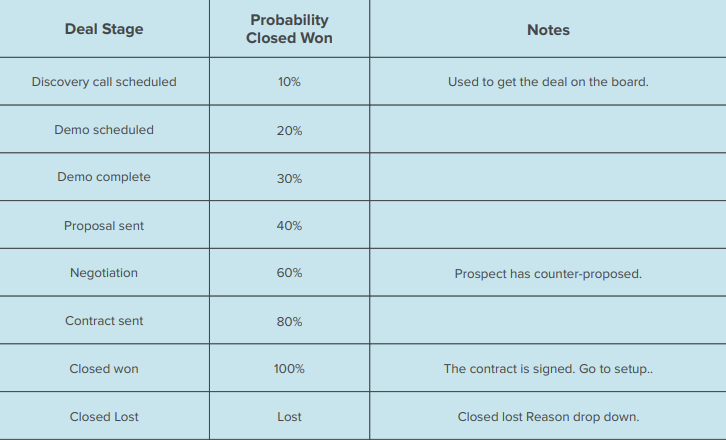
Over time, a sales manager or sales ops team can use actual data to determine what percentage of deals close by stage. And you can take that to the bank.
What is the Minimum Needed on a Deal?
These are our minimum requirements for a real deal:
- Deal amount
- Close date
- Company
- Contacts
1. Deal Amount
Sales reps notoriously don’t like to put deal amounts on their board and will be reluctant to do so because of sand-bagging, or they feel it's bad luck to say a figure out loud. A deal is not worth ZERO dollars at any stage. It may be 0% likely that a deal will close, making it worth zero, but the percentages come from the deal stage, not the amount. And sales reps have to understand the difference. As the sales leader, decide whether your deal board will reflect some Total Revenue amount (project), MRR (monthly recurring revenue), or ARR (annual recurring revenue). Then give reps guidelines for deal amounts. For example, the rule could be, “Until you have a real conversation with the prospect, SMB MRR will be $2,500, and Enterprise MRR will be $10,000.” Period. And as the sales leader, you MUST expect to see 100% of deals with an amount and use reporting to enforce it.
Orange Break
We have seen deal boards with 100% of the amounts set at zero until the deal stage “Closed won.” What is the point? The sales reps were managing their work outside the CRM because they had to have some idea of their potential income, but their sales manager didn’t require a number on the public deal board until the prospect signed paperwork. Who knows what manager and rep discussed and which tool they used in their 1-1s. 🙄

2. Deal Close Date
A CRM can populate a deal close date by using some kind of default or formula. For example, the close date could be 90 days from the deal creation. We have no problem with calculated dates, but we ask that the date be maintained and be as good a guess as possible.
It makes us crazy to see deals with close dates that have passed. The rep needs to evaluate these deals that have not moved and honestly ask themselves, “Can I get a hold of this person?” If not, they have to mark the deal as closed lost and kick it back to marketing to nurture.
Reps can always resurrect a dead deal. The rep can mark a deal as “Closed lost,” or they can push the close date further out. And either way, that's going to be more accurate because of the expected value calculation of the deal board.
Orange Break
We have seen deal boards with long-expired deal close dates. Upon further investigation, we discovered that as soon as the sales rep releases the deal (Closed lost), it goes back to the lead pool, and the rep has lost all rights to it (no longer owns the contacts or company), no matter how much work they had done with the prospect. Sales commission rules about who owns what incented reps to have crappy unrealistic deal boards. We always ask to see the written comp plan for the sales reps. The commission structure instantly reveals potential aberrant sales behavior (from the perspective of marketing).
Note the difference between the “gross” sum MRR and the expected value. If you provided your investors the total pipeline, they’d think, “whoa, these guys are rocking!” But it wouldn’t be real. You have deals in early stages and past due deals on the board and ones that have gone dormant, artificially inflating the forecast. If you give the forecast to the investors as if it were fact and then miss by (the difference between the total and the expected value), that is worse than telling them $193,000 as the forecast to start.
Orange Break
We have a friend that is one of the best sales leaders in North America as far as we know. He keeps his forecast accuracy within 5% using strict processes, diligent pipeline management and review, and maniacal use of historical data to understand the likely close rates from each stage. Investors love this guy. Just ask his bank account.
3. Company
It sounds crazy, but all deals need to have a real live company connected in the CRM. It should be the actual company, so you know that this is a real potential deal. Fact vs. fiction wins every time.
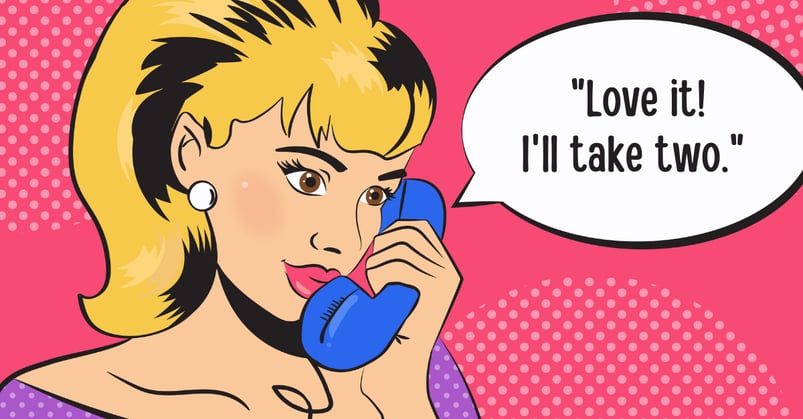
4. Contacts
Finally, the deal needs the real prospect’s buying team members’ contact information attached to the deal in your CRM. Why?
- These are the contacts the sales rep needs to move the deal through the pipe, giving weight and legitimacy to the forecast. And it provides the Sales Manager something to review.
- In many CRMs (HubSpot for sure), you can see all of the communication across the buying committee in one place on the deal record.
- And, when the deal is “Closed won” or “Closed lost,” it allows marketing to tie the deal back to marketing campaigns and ascertain the effectiveness of various efforts. Marketers ply their craft on emails, addresses, and phone numbers that belong, ideally, to live human beings. Without people tied to a deal, there is no CRM under God’s green earth to figure out the effectiveness of marketing efforts.
Orange Break
In the interest of not making this e-book any longer than it is, we will leave details about additional marketing strategies up to your imagination and a brainstorm with your agency or marketing team. We have done it all including “Have a face-to-face meeting with your sales rep for a one in a hundred chance to win a Harley-Davidson.” Our Direct Sales team at the time was super happy.
What Sales Roles are Critical to Start in a Company
For most SaaS businesses, two sales roles are minimally critical on a sales team to operate at scale: the Account Executive (AE) and the Sales Development Rep (SDR). Though these names and definitions may vary (Business Development Rep or BDR vs. AE, Inside Sales vs. SDR, etc.).
1. Account Executive - AE
An Account Executive (AE) is a straight-up commissioned sales rep. This person is dedicated 100% to selling your product. Their compensation is highly leveraged (50% or more of pay at-risk), and they eat what they hunt and kill every day. We think of their efforts as primarily outbound. In the beginning, when marketing lead volume is low, an AE may be working on both outbound prospecting and inbound marketing leads.
2. Sales Development Rep - SDR
A Sales Development Rep (SDR) is generally a salaried position, with incentives for completing a set of tasks designed to set appointments for your AE. They may get SPIFs (Sales Performance Incentive Fund) on appointments made for an AE and then kept (incenting the SDR to ensure the prospect goes to the meeting). When marketing inbound lead quantities become higher than 20 to 30 a month (one to two a business day), an SDR role is required, or else you are leaving money (revenue) on the table because your AEs do not have time for the care and feeding of deals AND inbound leads
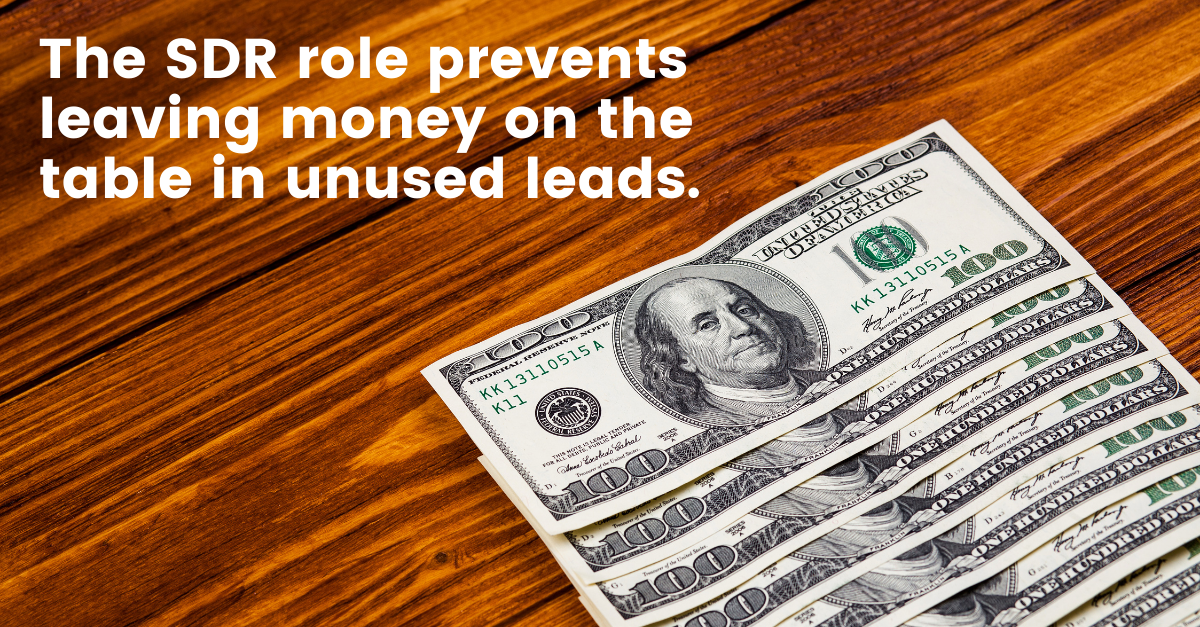
Why do you need both roles?
Both roles are needed primarily because of compensation structure and how that drives rep behavior. The law of unintended consequences is that if you are paying an AE for closed deals, and let's say you're paying them handsomely for their closed deals, for example, Susie AE is paid 20% of everything she closes. Susie AE will only focus on getting close to the finish line and pick and choose among anything she can find that looks and smells like she might be able to win it.

Again, This is the antithesis of what we want to see, a repeatable, consistent process. Susie could be very talented, and she could just look at some lead in your database, look at their website and think, "Ah, I can make this work."
And if you could get yourself a pack of Susie AEs, you're going to get to the finish line in no time. Sadly, you can't. Talented AEs are not lying around unemployed. The SDR role helps fill this gap because you can pay an SDR for activities that will consistently help screen prospective customers who will be a good fit. If you pair this with an excellent training program and a playbook for AEs, you can hire someone off the street who will be within a standard deviation of your best reps. Investors love this because they know Susie could be hit by a bus or poached by a competitor, and you will continue to make your number.
With Susie focused and paid on the near-term deals, you need someone else concentrating on the prospects who have a longer timeline and maybe hiding in the shadows. We call what Susie AE is doing "cherry-picking." It's a fact: 100% of all commissioned sales reps will work on what they think has a better probability of closing. That means they will ignore everything else.
At scale, this also means they will ignore a high percentage of your marketing leads which are naturally longer-term prospects simply researching answers to the prospect’s problem. Your SDR is paid to dig deeper with incentive comp on activities against leads and appointment setting. "I want you Mr. SDR, to consistently, in a consistent way, get a hold of these people, determine whether they're a good fit for us now or at some point, or whether they are unqualified forever."

Why does Susie AE cherry-pick?
She has more leads than she has time and needs to prioritize based on her perception of her ability to close ASAP.
How does Susie AE cherry-pick?
Who does she call?
- Have a demo form fills
- Contact us form fills who have a company email address that is a target
- Referrals from a partner website
Who does she NOT call?
- Gmail.com or any freemail email address
- She is not calling your paid social leads as most people use their personal emails for their social media, even LinkedIn. And you may have paid between $300 and $600 each for these leads. Take ten minutes and go ask a sales rep you trust, “Hey Susie, between you and me, do you call Gmail.com leads?” You are welcome.
- “Download content” leads
- Webinar registrations
- Contact-us form fills unless she likes what they say in the comment box or likes their email addresses.
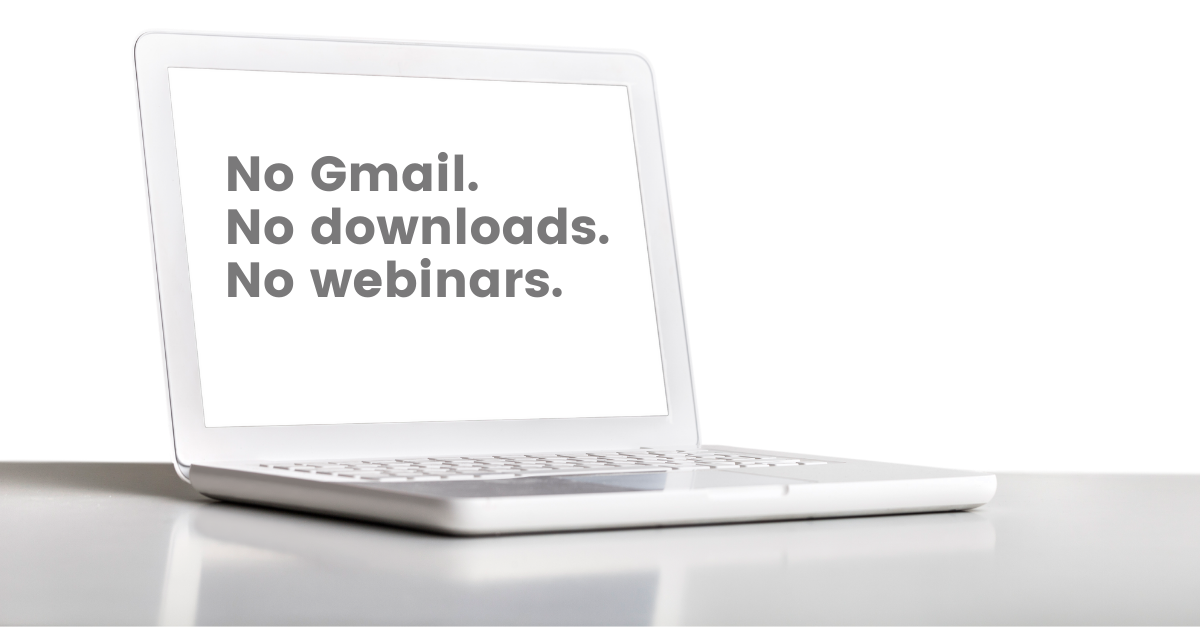
And she’s not wrong. Statistically speaking, somebody that says, “I need a Demo” is lower down the funnel than somebody who downloaded a white paper from a LinkedIn ad. Those two leads have two different likelihoods of conversion. Still, there is wheat in the chaff of the people who downloaded white papers from LinkedIn ads, and if Susie AE consistently chooses the "Have a Demo" form fills, she is missing them. These uncontacted prospects are a loss for the company and marketing. Not for Susie. Susie is going to do just fine.
Orange Break
“Cherry picking” comes from our painful IRL experiences. We get hired to generate leads for SaaS startups. All kinds of leads start flowing in, including top of funnel leads like content download. The sales team responds with, “We don’t like that stuff.” 😠 Leads for nobody.
We have learned to ask some serious questions up-front about the sales team structure and the compensation. We let whoever is paying for us know that leads will fall to the ground when marketing begins generating volume (scale) unless sales has the right system in place. And the marketing ROI won't be great without this system.
We have even seen sales managers support this “don’t call content or Gmail leads.” Statistically, this is just not good business. For an 18 month period, in a recent client analysis we found just 17% of contacts that became customers came from a one-time demo or contact-us form, but 82% started as content conversions.
With leads processed completely using a consistent process, we can determine who is a good fit but not ready to buy. And those prospects need to be thrown back on the pile (disqualified) and nurtured by marketing. With an SDR role in place, you will find one or two out of twenty interested in proceeding immediately; an AE would have overlooked that due to something silly … like a Gmail.com email address.
How Do You Prioritize Which B2B Leads to Contact?
Our philosophy is “every single lead must be processed using a consistent process every single time.” Processing all leads seems logical. But in practice, sales teams push back on what they feel are junky leads. And sales treats download content leads and Gmail addresses etc., as junk, which puts sales in diametrical opposition to the marketing team paid to create that junk.
Here is how we explain to a B2B SaaS sales team why these download content leads are not junk.

Your company is NOT giving away trips to Disneyland. Why are people coming to read your content — some sort of detailed white paper or webinar video about, say, AI SaaS Finance Software? Let’s enumerate the possible people who would be downloading this highly technical content:
- Students
- Competitors
- Job applicants
- Vendors or partners
- Russian spies
- A prospect looking to solve a technical problem now or in the future.
To find person #6, you have to deal with numbers 1 through 5 because now and again, some small percentage of #6 will say, "Yes, I'm actively looking for a solution right now, and I want to buy what you guys sell, yesterday."
Another example: you provide booking keeping and accounting SaaS software solutions. Somebody downloads your white paper on “How to select a SaaS accounting solution for your business.”
What are the possibilities (if they are not numbers 1 through 5)?
- Prospect has no solution for bookkeeping and accounting right now.
- Prospect is dissatisfied with their bookkeeping and accounting solution.
- Prospect is under contract with their current bookkeeping and accounting solution, but it expires next year.
- Prospect is in the bookkeeping and accounting world and is checking out solutions.
They are incredibly unlikely to be a cashier at Walmart (not that there's anything wrong with that). Whether it's now or later, this person may be valuable to your company. And it's worth reaching out to them, establishing yourself as an expert in bookkeeping and accounting, giving them a positive first impression, hopefully with a little bit of a give. "Here's some other information you might find valuable."
What's the harm in connecting? Companies and sales reps think they're clever and can figure out which of these people poking around are buyers and which ones aren't. Our presumption is sales reps simply cannot. Given any kind of lead volume, they will make horrific mistakes. And their lead selection process is not consistent, repeatable, or predictable. It is better than random, but not by much.

Lead Scoring and Why We Hate It
Please humor us with a quick digression into how metrics can go bad. Marketing is incented and provided a budget to CRANK out leads. Sales is incented to CLOSE deals. When sales complain they have too many leads to sort through, marketing responds with, “I’ll score your leads, and you will know who to call.” 🙉 This scoring solution makes everyone happy. Marketing still gets to hit their MQL numbers. And sales is now permitted not to process the leads. 🙈
What the actual F? Who is losing out here? 🙊 EVERYONE. The company is paying for leads nobody uses. Marketing’s theory is that by uncovering leads, and executing marketing against them, marketing will nurture the prospects to “buy now.” Unfortunately, “sales and marketing” is a team sport. Marketing does not sell, and marketing’s content does not sell, and prospects do not always voluntarily raise their hands. Sales must expend efforts against leads.
We get aggro about organizations NOT producing thousands of leads a month who want to implement lead scoring. How about instead of creating more leads than sales can handle, you decrease your marketing budget? Or decrease your lead count by putting barriers in place like increasing form questions. Or increase your sales headcount? Take your pick. We don’t care.
Orange Break
Math with us for a minute. You have 2 AEs and no SDR. You are paying for and getting 90 leads a month (costing you about $20K to $50K monthly). That is ~2 per business day per AE. If you are asking the AEs to make 9 attempts against each lead over the space of two weeks, AND work their existing pipeline, they get to a point in just two weeks that they need to do 14 tasks per day just in new leads assuming NONE of the leads develop to deals quickly. But if they are also working 10 to 20 live deals, lead nurture is not happening. How are you feeling about your $20K to $50K monthly marketing spend now?
Why else do we hate lead scoring systems?
The algorithms get overly complex, break and start doing things that no one expected because the calculations aren’t audited and watched. And pretty soon, Mr. Perfect Prospect is not fed to sales. And whose damn fault is that (marketing’s BTW)?
The lucky few have more leads than they have people who can reach out to them (e.g. thousands a month) and require lead scoring. But those are already scaling businesses, very possibly ones that are product-led. We’re okay with those B2B companies using lead scoring and other tools to prioritize leads for outbound calling. But if you're getting ten or twenty or fifty leads a day, just call. Email, and LinkIn them all. And multiple times (our number is nine total, more about that later).
Orange Break
We keep saying “call.” Isn’t cold calling dead in B2B? We’ll give you that cold calling has low response rates. We don’t advocate that you buy a list and pound the phones. But leaving a message for someone who has downloaded content or watched a video isn’t cold and statistically has proven to be effective. Don’t get us wrong. We love a sales email template sequence, and we know that automated email is a sales rep standard play in this day and age. But we remind our customers that email inboxes are beyond cluttered. As of 2020, DMR reports the average office worker receives 121 emails a day. We train our clients to use cold calling and email templates because they both work when done correctly.
What Are Lead Processing Best Practices?
We want to touch on lead processing best practices that get results. First of all, you need a Sales CRM or bundle of tools that can handle these basic activities:
- Email templates
- Sales sequences
- Dialer
- Tasks
- Email and call tracking
- Calendar scheduling links
- Deal board stuff (pipelines and the like)
We prefer an integrated sales and marketing product like HubSpot, which is perfect in the B2B space. Not only is its price point reasonable for the number of tools and functionality you get, but its implementation process is quick (weeks, not months) and relatively pain-free. (Full disclosure, we sell HubSpot.) In addition, maintaining HubSpot does not take a full-time sales admin expert, like Salesforce.
Your essential three sales processing functions that need to be facilitated by your CRM:
- Follow-up on deals
- Process inbound leads generated by marketing
- Outbound prospecting generated by sales reps
Orange Marketing
Many sales managers immediately turn to Salesforce as their default CRM (based on experience and comfort). We implore you, look at options and understand the TCO of Salesforce. We have worked in Salesforce organizations plenty of times, but if you set up a sales function from scratch, don’t just buy Salesforce because Salesforce is what you know. Things have changed.
How should sales reps organize their work?
At scale, we encourage our B2B sales teams to group tasks to get some efficiency in their day. Generally, sales team members report that they like to do their more complex tasks in the morning, like calling, and less demanding tasks like administrative CRM work and research in the afternoon.

Let’s step away from this idea of lead processing for a minute. To make an apple pie, you need about eight apples. How do you process those apples? Do you wash, then chop, then put in the pie crust - one apple at a time? Or do you wash all the apples, chop all the apples, then dump them all in the pie crust?
Sales team members often find themselves jumping around from task to task doing wildly disparate activities back to back. We work with our sales teams to group functions into bundles within their task processing software of choice (again, we use Hubspot). For example, let's say you did a webinar, and you got 100 registrations (leads) from this webinar. We strongly recommend that you call these one hundred people in addition to sending multiple emails and perhaps ending with a final call.
Ideally, you make 100 phone calls that say, "Thanks for your interest in our webinar." If you do 100 of them in a row, primarily if you use some CRM integrated tool that facilitates ringless voicemail drops (like Kixie), you can quickly power through 100 first phone calls.
Rather than if a rep's day looked like: "Okay, this one was a follow-up from a webinar. Now this one was a deal that I was working on. And now I need to follow up on his contract. And then this one over here requested a demo, and I want to see when they want to schedule." It's like the apple example. It's insane to do those tasks out of order when you could do 100 of any kind at once.
We like to use tools to structure the processes and provide reps with context-sensitive tasks. Do all the tasks in one context, and then move on to all the tasks in the second context. It magnifies rep productivity by 3X or more.
What are email templates and sales sequences?
Whatever sales tool you use, it has to facilitate sales email templates and sales sequences and multi-contact enrollment into a sequence.
- Email Template - With templates, you can save repetitive email content as an email template. Before sending a template, you can personalize and tailor the content to your recipients. You can access templates from the CRM or when sending an email from your inbox.
- Sequences - With a sales sequences tool, you can schedule a series of tasks, including automated emails, calls, social selling, and other tasks over time. When contacts reply to the email or book a meeting, they will automatically unenroll from the sequence, kicking off a new deal, or be closed as uninterested.
These tools are the bread and butter of sales prospecting: these and a dialing tool.
- Sequences allow you to send a series of emails to your prospects at scale.
- You can enroll multiple contacts in a sequence, up to about 500 a day (limit of your email client).
- You can personalize some of the emails before the kickoff of the sequence.
- The emails go straight to the prospects’ inbox via the sales rep’s company email, rather than through marketing’s mass email capability.
What is the advantage of sales sequences vs. marketing emails?
- Sales sequences have higher deliverability straight to the inbox
- Vs. marketing emails which typically deliver to a bulk email folder
- Sales sequences enable WILD personalization that will get sales emails noticed
- Vs. marketing emails which have to be more general by definition
We recommend that marketers create the email templates in the sales sequences as specific to a segment as they can afford to be. Radical segmentation will allow you to have personalized emails that aren't personalized.
Say, for example, we are targeting people with BMWs. If we have a segment of customers that all have BMWs, we can write a sequence about the benefits of BMWs, how fast they are, and how they make you look cool. It can be all about the BMWs, and we don't have to write any personalization. We can send this email to 100 people at a time and they will feel like the email is just for them.
Orange Break
One of our clients had an attractive segment in their B2B database -- they had a ton of success selling their finance SaaS product into mega-churches. 100% of the time, they modified the language of any sales or marketing emails to this target. They had found that their mega-church prospects had different measurements of success than other typical businesses (for example, donations utilized to further their mission). And as our client said, the more ♰ crosses and ⛪ churches in the communication, the better. Religious communication was a first for us in the SaaS space, but the client was dead-on. This prospect responded much better to faith-based communication than the standard B2B drivel. It was not only worth the effort, it was required. And we learned a lesson.
What is the “I hate money” Club?
The “I hate money” club has sales team members who won’t engage in basic recommended activities to close sales. Because they are commission-based sales reps, they seem to hate money. Sometimes, they are simply already making extraordinary compensation, and they don’t need more money. 💰 Who are the card-carrying members of the “I hate money” club?
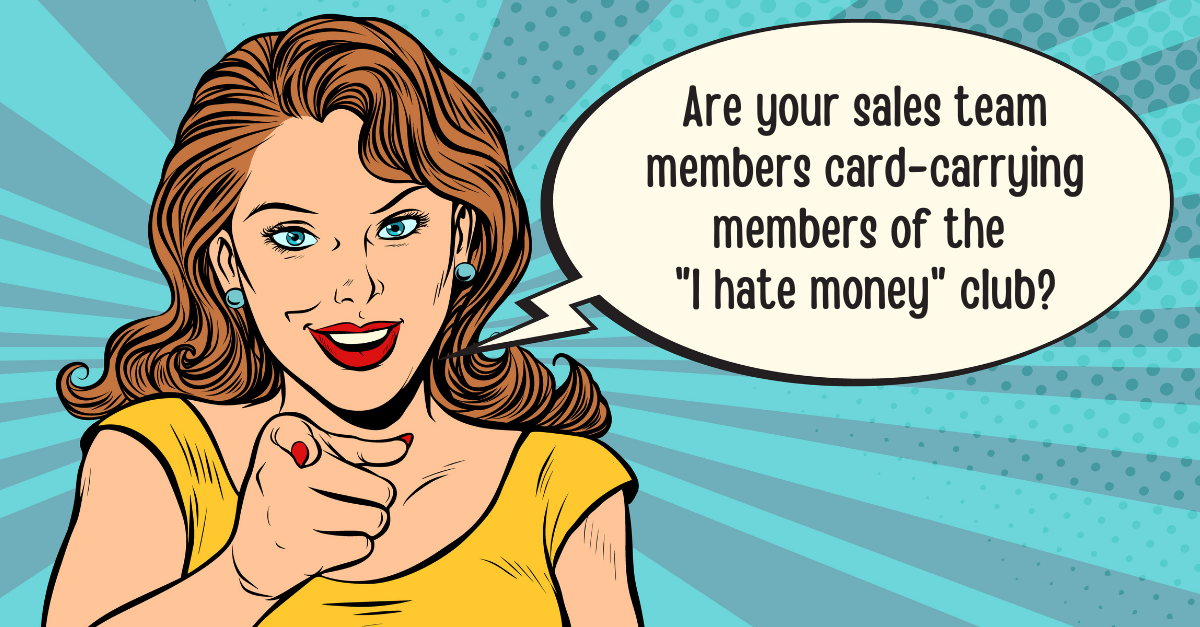
Six Members of the "I Hate Money Club"
1. Sales reps who will not dial a phone to save their lives
So for whatever reason, these reps think that the phone is not going to work. And we agree, contact rates are low. We agree that most of the time, those voicemails go unanswered, but we disagree that you shouldn't call for that reason because of the other items that we have mentioned. Your email may not get to them. And if these people were genuinely interested, you want to try to use as many forms of communication as you can. And in today's world, you have a wide variety of choices, but the phone is one that everybody has.
And so, collect their phone number or get it through one of these other tools widely available nowadays. And then call it or text it. See what happens. What's the worst? The more ways you reach out, the better your odds of selling.
But if you're going to utilize phone calls, have it be from somebody who knows a bit about your business, who can ask an intelligent question, who has looked at the prospect’s CRM contact record and figured out what they have done, and maybe knows a tiny something about the opportunity.
Otherwise, if you have your offshore team dial, and the prospect answers the phone, and the offshore resource starts babbling without listening, then you are going nowhere fast. Don't waste your money.
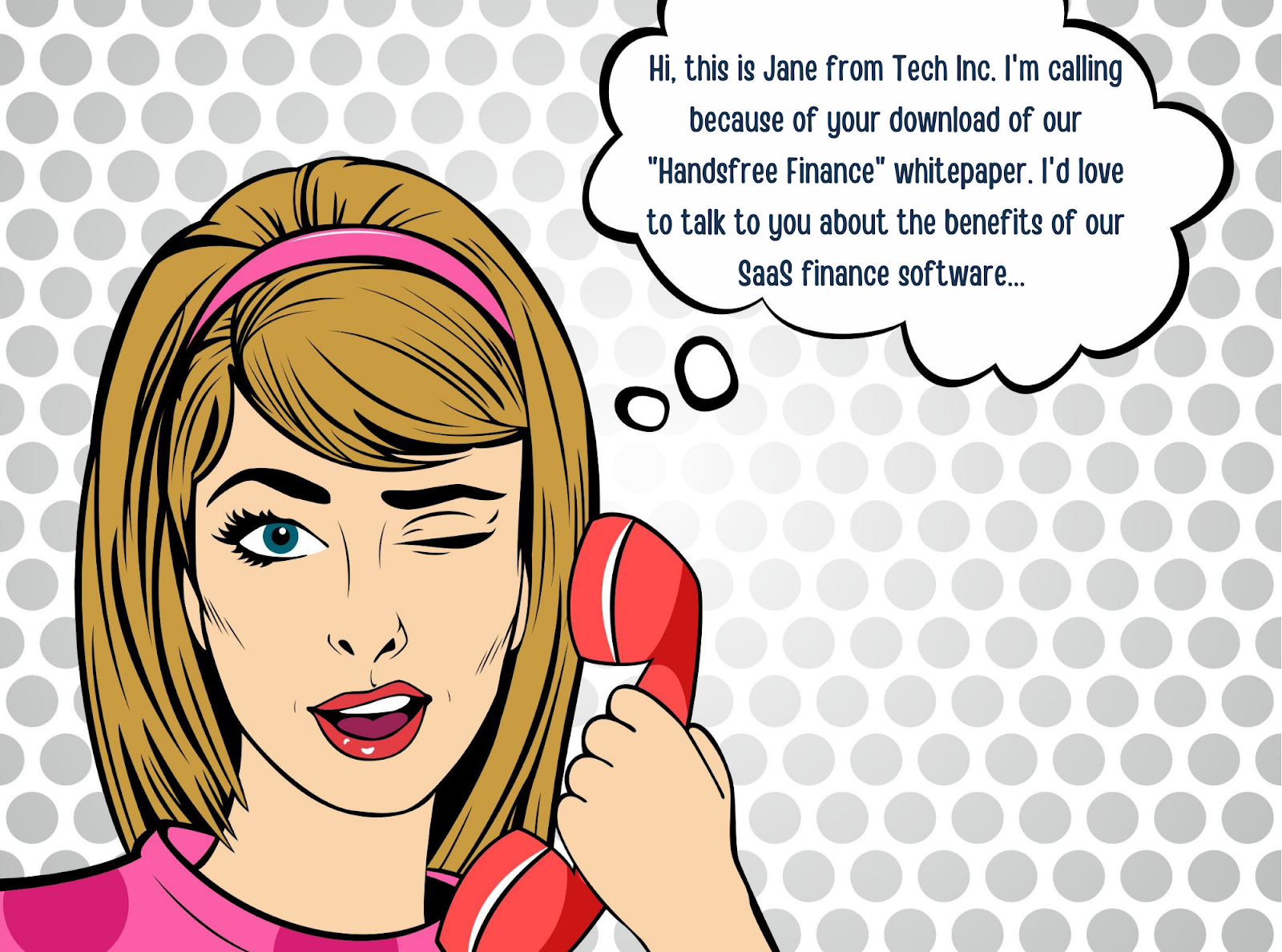
Orange Break
We both go way back to the dawn of time when direct mail was a thing. There is nothing like a FedEx envelope with a clever, personalized message and a gift to break through the clutter. If you genuinely know who your target is, why wouldn't you? And yes, we know people are working remotely. We have ways of dealing with that, too (see our holiday gifts during COVID-19 article).
And the adage, back in the day, was the more methods you provided the prospect to respond, the higher the response rate. And that is 100% still true today. The more ways you reach out to people, the more chances you get a response. Think of all of the tools that reps have at their disposal today.
- Phone
- Text
- Messaging apps
If reps wanted to get a hold of prospects, they could.
2. Sales reps who will not contact Gmail.com email addresses
This subject wraps us around the axel hard. We wrote an article to vent one day after the 47h conversation about just this subject, “Do Your Sales Team Refuse to Follow Up on Leads?” It just drives us bananas when we run into sales teams that won’t follow up on leads with a Gmail address or other free mail address. Even worse (in our humble opinion) are marketers who limit their form fills to only taking corporate email addresses. We were sorry when HubSpot started offering this option. Read our article to understand how we feel. Here is the Cliff’s Notes version of why someone might use a personal email in a B2B marketing form:
- Their company uses fancy technology that prevents “spam” from getting through; therefore, the only way for them to get your downloadable content email is to use a personal email. And they want your content.
- Their computer or device auto-filled their email, and they didn’t notice.
- They use their personal email out of habit.
- They are uncomfortable using their corporate email on the internet.
- They don’t want to tip their hat to a vendor that they are shopping around, and they are hiding.
Still not convinced? Let us seal the deal for you. If you spend money doing paid advertising on social platforms like LinkedIn and Facebook, their inline lead forms generate the best conversion rates. But guess what? Nearly 100% of the time, people sign into social media with a personal email address. And just recently, Google came out with Google lead form extensions which automatically populates people’s information into the lead form. And 99 times out of 100 it will be personal information.
If you have money, you can equip your sales team with clever fancy tools which do reverse lookups on personal emails and the like to solve “the problem.”
Orange Break
We had one client who could not figure out why they got a ton of leads from Harvard, Princeton, and Stanford. It turns out we were using Linkedin Lead Gen Forms, and we quickly realized that their prospects, who were data science engineers, love to retain their alma mater’s email address for personal communication. You know. The degree flex. 💪 Who knew?
3. Sales reps who view emails from their CRM as "inbox clutter"
When we have correctly set up our Sales & Marketing world, the CRM will start sending many email notifications back to reps. Excessive messages could be due to a variety of reasons:
- The CRM’s notifications throttle is set very sensitively (typically controlled by the rep)
- Marketing emails can be sent out from the contact owner’s email, causing bounced email notifications back to the contact owner (the rep)
- Sales management or other reps have asked Marketing to implement “click notifications” on marketing emails, notifying the contact owner that a prospect has clicked on an email.
Orange Break
CRM emails can overwhelm reps and cause them to send (perceived) weird complaints back to marketing. An excerpt from a real email we received from a real sales rep at a true SaaS B2B company follows.
"Hi - today I received about 50 emails from HubSpot, from people I presume clicked our link and downloaded information. I would like to talk about how to isolate these emails, so they are not cluttering my inbox."
This experienced AE complained about too many leads and dared to call them "inbox clutter." 😡 We talked to the founder and explained why he needed an SDR ASAP. Or we would stop taking his money for “marketing."
Sometimes sales reps are thrilled to learn more about what is going on with their prospects via CRM email notifications. Other reps lose it. These reps cannot handle the volume of email generated by a CRM (especially those wed to the early 2000’s productivity concept of inbox zero), and consider email a hindrance to their “inbox zero” effectiveness. 🙄 If possible, we educate reps on the various emails generated by a highly functioning CRM and introduce them to the email tools that will help them categorize and prioritize this communication.
4. Sales reps who follow up on a lead only once and believe they have done their job
Many studies, stats, and opinions exist on how many times a salesperson should follow up with a lead. All studies agree on one point. ONE follow-up email or call is not the correct number. Research generally agrees on between six and fifteen. For us, the number is nine. We define these nine as:
- 5 Emails
- 3 Phone Calls
- 1 Social Media (like LinkedIn)
Here is an excerpt from one infographic backing up our point.

Seriously, have your formula be what you will, but make a concerted effort at your prospects and with a tracked and reported procedure. Dictate (we did not accidentally use that word) a number and type of reach-out that you insist your sales team use repeatedly with different types of leads. Your recipe for “download content” can be different from a “contact us” lead, but create a standard and stick to it.
We freely acknowledge the law of diminishing returns. After some number of efforts, you're probably not going to reach the person.
Orange Break
We had an SDR at a client a couple of years back whose average number of attempts against the contact was around 100. He just kept after them. For several years, he followed up on prospects with brand names like Oracle, Google and Microsoft. We were boggled by this, and we asked him why. He said, "Well, because that one time ..." That one time on like the 75th try, he landed a big deal. Statistically, this outcome is improbable. And statistically, he was wasting his own and his company's time.
Pick a number and let your reps know that contacts beyond the number you have picked, say nine, are simply wasted or diminishing marginal returns for your business.
5. Sales res who send emails that say, "Did you see my email?"
We will not justify this with a long story and specific example. Please, please, pretty please, please, please stop sending emails like, "Did you see my message?" Well, yeah. Maybe we did. Perhaps we didn't. Who knows.
We contrast this approach with the real-life example of an excellent email personalized by somebody who bothered to research our company. They referenced two clients they knew we had worked with and the fact that we worked together.
Attempt to ensure sales team nurture emails help the prospect in some way versus being about your company and your need to sell more. Some examples:
We are constantly trying to find new tools that will help our clients, and therefore, we purposefully look at cold emails every day. We for sure do not get value-added email. When an email is helpful, empathetic, and has the tiniest bit of true personalization, we take the meeting because we like to pay it forward. 😀
6. Putting leads back in a “shark tank” after a rep fails to sell
We want companies to have reps bang their hearts out for whatever the number of contacts is, say nine, following the prescribed play. Then at the end, if the prospect ghosts and goes quiet, the rep throws the lead back to marketing via some flag or trigger, like a lead status of "nurture." The sales reps must trust their marketing team will work hard to resurrect the prospect's interest.
Then, when the prospect comes up for air again by downloading content or registering for a webinar, the lead goes right back to the same sales rep for further contact, which begins the entire sales process again.

Some sales teams remove the original contact owner and put the lead back in the general lead population (shark tank 🦈). The sales rep must trust that they will be reassigned this lead if the lead comes back because if they do not trust this process, you will start to see some squirrely behavior. Some companies remove the original contact owner and put the lead back in the shark tank. Reps in these companies will continue to work the contacts beyond diminishing marginal returns, just on the off chance that it turns into something, instead of putting it back where it belongs. They are afraid when the promising prospect comes up again. Some other rep will grab it.

Summary
Remember the iceberg. 🧊 It’s what's underneath that matters more than what you see on the surface. If you can implement a scalable, repeatable, and predictable process as an early-stage startup, you will be light years ahead of most of your competitors. Ensuring sales and marketing are on the same page from the get-go and rowing in the same direction helps B2B startups generate revenue as quickly as possible. Here’s our checklist:
- Have clear rules around deal creation, including stages, amounts, close dates, company, and contacts.
- Have a budget for an SDR function that accompanies your marketing spend. Know how many monthly leads trigger onboarding an SDR to support your AEs.
- Contact all your leads multiple times. And have a specific number of times required with particular types of activities, including phone calls.
- Have a lead processing playbook and measure your AEs’ and SDRs’ activities against the playbook rules
- Give your sales team tools like a dialer, templates, and sequences, and make sure they know how to use them. And measure usage and effectiveness of templates and sequences by rep.
- Watch closely for dysfunctional behavior among your sales team members that you may be incenting (law of unintended consequences) or caused by too many leads and too few reps.
- If you begin to suspect your marketing or sales team are members of the “I hate money” club, figure out why. And fix it.
There will be good, albeit sometimes bizarre, reasons for whatever your sales team members’ behavior. Change the incentives, comp, tracking, whatever you have to do to nip it in the bud.
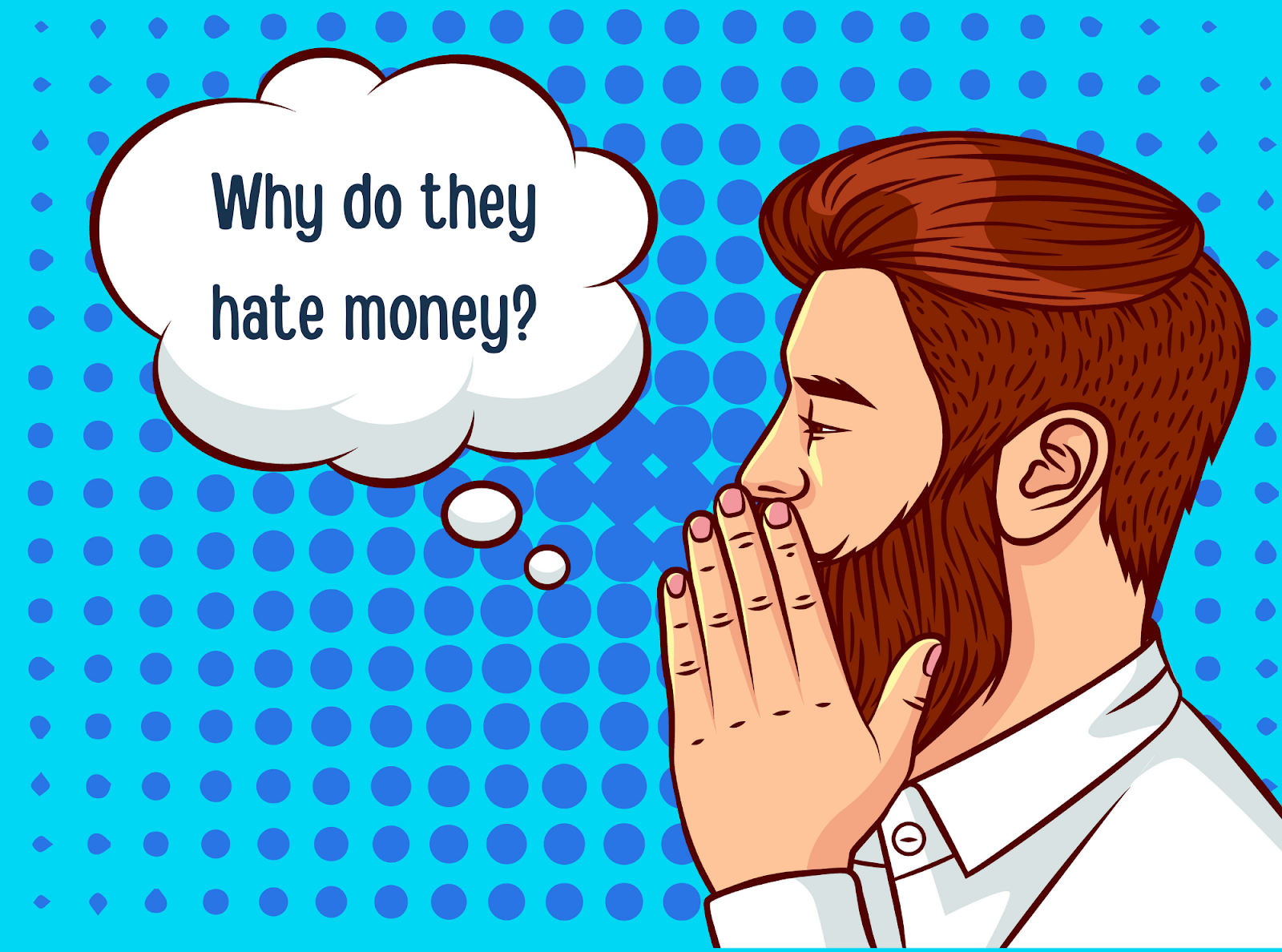
By now, you realize how close we feel sales and marketing must work together to enhance each other’s effectiveness. Working as a team with documented rules and expectations around lead processing will increase marketing’s lead quality. Sales will ultimately close more deals from the existing lead pool. And drive Teslas, which is what all of us want. 💸



